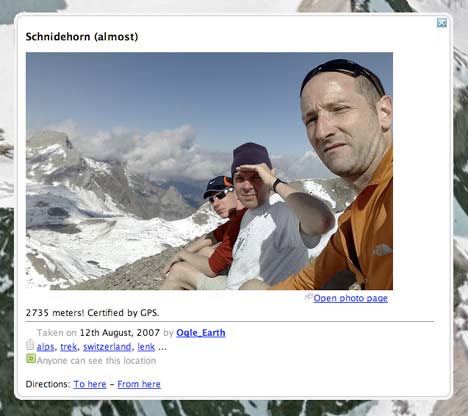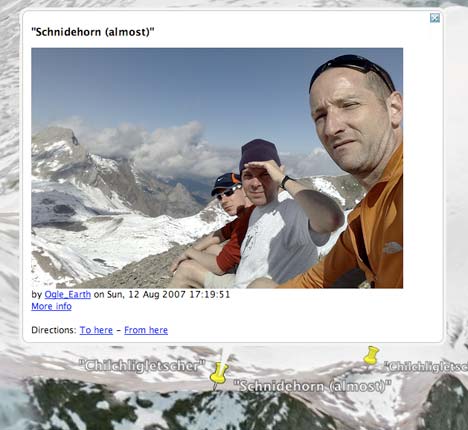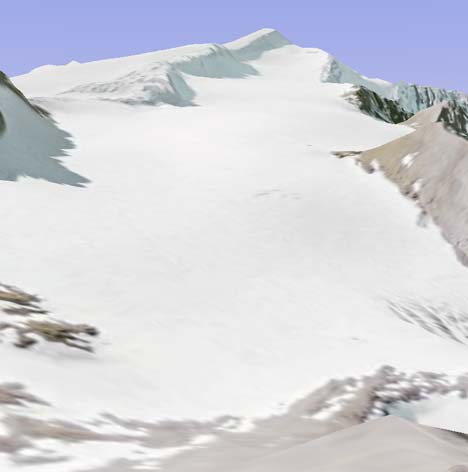The pictures from last weekend’s little Alpine trek have now been geotagged and posted to Flickr, providing a good opportunity to test the latest methods for getting these images onto Google Earth.
Although my camera was the Nokia N95, I didn’t use its built-in GPS receiver to georeference the photos as I took them (which you can, using Shozu). There were numerous reasons: The battery just can’t handle constant GPS tracking, I didn’t want to wait a minute or so to first get a GPS fix every time I took photo, and Shozu only geotags the photos for Flickr, not to the EXIF data (Nokia offers no OEM solution). Instead, I relied on my Garmin GPS receiver (which takes AA batteries), logging my route in order to later correlate times with HoudahGeo or GPSPhotoLinker (both for Mac), adding EXIF coordinate metadata thus.
My plan went awry when my Garmin was stolen out of my rucksack in transit (!) but the route was still fresh in my mind, and with Google’s Swiss data being so accurate, I could easily retrace my steps. I therefore made good use of Geotagger (for Mac, site currently down), which georeferences photos dropped onto it with the coordinates of the current view in Google Earth.
Then it was time to import the photos into Aperture (for Mac) and upload them to Flickr. (Note: With Aperture you can’t do round-trip external editing for EXIF tags such as coordinates (dumb), so you have to georeference them before you import.) After some editing in Aperture I used FlickrExport to get them to Flickr. Here is the set. And here’s what they look like on Flickr’s Map.
How to turn them into KML, so they can be viewed on top of Google’s fantastic Swiss imagery? I compared the two best methods: Flickr’s home-grown method, added last week by Dan Catt, and Steeev’s Yahoo Pipe, which uses the Flickr API and which has been improved since I last used it in May.
Here is the KML by Flickr, and here is the KML by Steeev’s pipe.
How did I fare? Both methods have one significant limitation in that you cannot filter by set when exporting to KML, even though you can filter by tag, user and group. The hack, then, is to assign a unique tag to all members of a set, and this works, but it is a bit, well, hacky.
I don’t think I’m alone in predominantly using sets as a way of organizing my photos. iPhoto ’08 (for Mac) just introduced “events”, which are very similar concept. It is simply that case that I tend to take photos in batches, for example when on a trip, and then upload them in one go, rather than have them trickle onto Flickr. The set for my trek, for example, contains 37 geotagged images.
This leads to one disadvantage for Flickr’s built-in KML generator: It only returns the last 20 georeferenced images for a given tag or user. In my case, it only returns about half the images I took on the trip. The others fall off the end of the feed.
This is not a problem for the Yahoo pipe. By default it returns the most recent 100 georeferenced photos, but if you need more you can just clone the pipe and increase that limit.
Steeev’s pipe has another clever feature: It takes a photograph’s time stamp and adds it into the KML, so that you can time-browse the photos in Google Earth. It will even let you add a bounding box to the filter, so that only photos within a certain region are returned — useful if you’re trying to find georeferenced photos from Paris, Texas, for example:-)
Flickr’s built-in generator easily has the best presentation, with mini photo icons that lead to well-designed popups:

The Yahoo pipe looks like this, by contrast:

Flickr’s built-in KML generator also looks neater in the sidebar.
Finally, the built-in generator automatically returns a network link to the file, so that it automatically updates as new photos are added. With the pipe, you need to take that extra step of building the network link yourself.
In sum, I’m wishing for a hybrid of these two solutions: The presentation and ease of the Flickr feed with the features of the pipe. In the end, I sent the pipe’s output to friends, because it had to contain 37 geotagged photos. For everyday feed-like geospatial monitoring of photos, Flickr’s solution is the easiest, though the lack of a time stamp diminishes its usefulness to geekier users.
What else can I wish for? I like the ease of FlickrExporter, which exists for both iPhoto and Aperture, and I wish there was something similar for Panoramio, as I think a subset of these photos would certainly fit there. It would be in Google’s interests to lure photographers into submitting properly tagged photos to Panoramio.
One more thing: Google’s Swiss DEM is very very good:


But then we knew that already:-)
Looks like a great trip. Love the mountains!!
Good to see y’all made it back safe and sound.
KoS
Humm, guess I’ll have to add the time in too! No idea why I’m not doing that anyway, must be having a dumb moment.
The plan is to extend the KML out into other areas of the site, hopefully by both the API and direct links (for the other 99.9999% of users), oh and sets probably wont be network links, but we’ll see.
For the moment I’ve been concentration on feeds that allow you to monitor updates.
Anyway, thanks for the write up :)
Very good post. Thanks for this. One question though: If you put your “flickr kml” onto some webspace and try to load it in Google Maps there are only the thumbnail pictures on the map. If you klick on them no pictures from flickr are loaded! Any hint?
Tom Coup
Sorry my site was down when you checked it, I run it from home and have left it with my family while I hike.
Also, you have the URL slightly wrong, without the http it’s pointing to your server not mine. It should be
http://craig.stanton.net.nz/software/geotagger.html
(and thanks for the plug :-) )